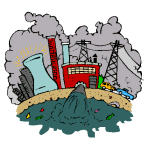
Industry & Power Generation

Industry and power generation are main sources of sulphur dioxide emissions, the precursor for sulphuric acid in acid rain. In the UK power stations and all other types of industry account for 90% of all sulphur dioxide pollution.
During the Industrial Revolution industries were often located in urban areas. Following the UK Clean Air Acts in the 1950s and 1960s, and with the decline in heavy industry, few large industries and power stations are located in towns and cities today. Many large industries are now located in the more rural areas of the UK. However, most urban areas have some smaller industries and possibly a power station. The larger industrial sources, even though located out of town, may still have environmental impacts on urban areas. If a town or city lies in the prevailing wind path of these industries, it may still experience some acid deposition, causing faster erosion of certain building materials and damage to urban vegetation.
Power stations contribute significantly to the total emissions of nitrogen oxides in the UK. In 1999, 21% of nitrogen oxides came from this source and a further 13% from other industries, iron and steel and refineries. The major source of nitrogen oxides pollution in the UK is now road transport (44%). Like sulphur dioxide, nitrogen oxides are also converted into acidic compounds when combined with water in the atmosphere, and contribute to acid rain.
Websites
Other topics
• Education Site
• Environment Agency
• Pollution Online
• International Energy Agency
• Friends of the Earth
• Environment Agency
• Introduction
• Agreements
• Buildings
• Cars
• Chimneys
• Critical Loads
• Deposition
• Doing Our Bit
• Emissions
• Europe
• Fossil Fuels
• Freshwater
• Impacts
• Industry Controls
• Industry & Power
• Liming
• Measuring
• Modelling
• Monitoring
• Natural Sources
• Nitrogen Oxides
• Rainfall Acidity
• Soils
• Sulphur Dioxide
• Transboundary
• Trees
• UK Acid Rain
• Vehicle Controls
• Wildlife
 Print Topic
Print Topic